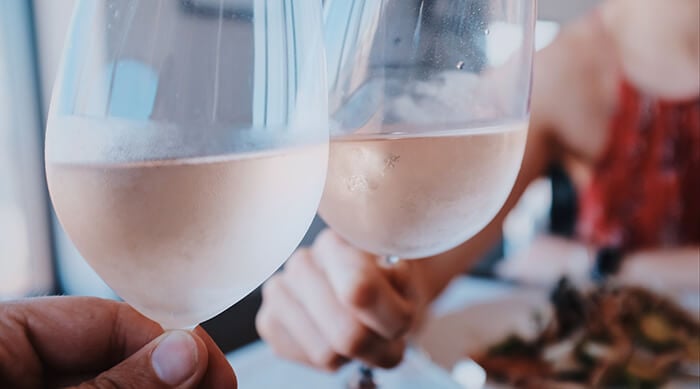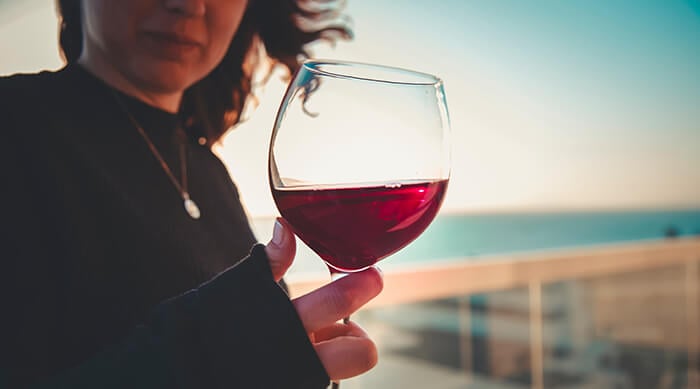You really shouldn’t drink rosé all day, no matter what you’ve heard.
Enjoyed in moderation, though, there are rosé wine benefits to be enjoyed along with that glass of your favorite pink drink.
Rosé wine’s proximity to red wine and the power of red grape skins is behind many of its health benefits. While that skin contact with the grapes is limited in the production process of rosé, the pink wine does come out on top when compared to the health benefits of white wine.
Looking for a low-sugar rosé, but cutting down on alcohol? Try Surely’s alcohol-removed sparkling rosé (now also available in cans)!
Is rose wine good for your health?
Rosé wine can be good for your health if enjoyed in moderation.
Red wine is the healthiest type of wine, but rosé has more of the antioxidant properties of red wine over white wine. Move over, chardonnay. Rosé is better for you because it’s pink.
As with any alcoholic drinks, any health benefits decrease the more you drink. If you already have your reasons not to drink, you shouldn’t start now just because we’re talking about the benefits of rosé.
If you’re wondering about the benefits in that occasional glass of rosé wine, you could do worse when it comes to the alcoholic beverages out there.
Benefits of Rosé Wine
That pink wine that’s so fun to look at and post about on social media can be good for you, too, as long as you’re sipping in moderation.
What are the benefits of rosé wine? Rosé wine benefits include a boost of heart-healthy antioxidants, reduced cholesterol, even a lowered cancer risk, all in a lower-calorie beverage.
Those positive health effects are thanks to its source of pigment. More interaction with red grape skins means a healthier glass of wine. The difference with white wines is that white wines are typically made from white grapes, which don’t have as many positive health benefits as red grapes.
The rare white wines made from red grapes have very little interaction with those skins. It’s the reason your favorite white wines vary in color from almost translucent to approaching apricot.
Red wines can soak with their skins for anywhere from a few days to several months. The deeper the wine — think cabernet sauvignon — the longer it’s been soaking with those grape skins.
Rosé wine production involves a more limited period of time where the red grape skins from varieties like pinot noir, syrah, or grenache are allowed to soak ahead of fermentation. That can take anywhere from a few hours to a few days, depending on the winemaker’s preference.
The deeper the pink hue, the longer it was allowed to soak with those skins, and the likelier that it has retained those healthy red wine properties wine drinkers enjoy.
The benefits we’ll share here are related to moderate alcohol consumption. Once drinking alcohol becomes excessive, you lose any of the benefits of rosé wine, possibly affecting your sleep and even your overall health in the process.
More Resveratrol Than White Wine
Rosé wine contains more resveratrol, a well-known anti-inflammatory, than white wine.
Resveratrol is a plant compound found in red grape skins. Many of the red wine benefits you hear about most often come from resveratrol. The compound is a polyphenol, a known antioxidant and anti-inflammatory.
The benefits of resveratrol include:
- Improved cardiovascular outcomes
- Lowered risk of certain cancers
- Anti-aging properties and protection against cognitive decline
- Lower blood pressure
- Decreased risk of rheumatoid arthritis
Rosé won’t have as much resveratrol as red wine, because it has much more interaction with those red grape skins during the winemakers’ fermentation process. That makes red wine the healthiest wine.
Orange wine (a style growing in popularity) and rosé come in a close second.
If you’re choosing between a rosé and a white wine specifically for those polyphenols, rosé will be the better choice. Look for darker pink hues if resveratrol is specifically what you’re after.
Reduces Bad Cholesterol
Those same polyphenols in red wine promoting good heart health are also found in rosé, just in smaller amounts.
Moderate consumption of rosé can help lower your LDL, or bad cholesterol, reduce your risk for type 2 diabetes, even reduce high blood pressure. These are all key components in the prevention of heart disease and heart attacks.
After a certain point, though, any alcohol overall can increase your cholesterol and cause problems in the liver, among a whole host of other issues.
Moderation is important when talking about any of the benefits of alcohol consumption, even when it comes to wine, and no amount of alcohol is safe if you’re pregnant or breastfeeding.
Key Minerals
The anti-inflammatory properties of rosé wine are associated with the compounds and minerals found in a glass of the pink drink.
Rosé includes a decent dose of magnesium and potassium, which help maintain healthy sodium levels in the body, reducing high blood pressure. Manganese in rosé promotes bone health and nerve function.
Keep in mind that rosé also has a higher dose of sulfites than many wines. If you’re sensitive to sulfites — which can look like bad hangovers, digestive symptoms, or skin rashes — rosé may not be the drink for you.
It may be the drink for you if you’re sensitive to tannins, though. Most rosé wines are low in tannins, found primarily in bold red wines. You’ll want to seek out unoaked varieties.
Drink Pink for Heart Health
It turns out that pink wine may not just be pretty to look at.
What is special about rosé wine? Rosé wine is special because it isn’t derived from any one style of wine grape, but gets its pink hue from the selected red grape blend or single type such as pinot noir or sangiovese.
The interaction with red wine grapes is what’s behind many of its health properties, and that pigment from red grapes is from anthocyanins. These are colorants that have been linked to a reduced risk of heart disease and a number of disease-fighting properties in recent studies.
These powerful flavonoids have been linked to:
- Decreased risk for cardiovascular disease
- Improved cancer, diabetes, and metabolic disease outcomes
- Microbial infection-fighting properties
If you want a dose of anthocyanins outside of wine, the pigments are found in fruits and vegetables that come in deep red, blue, and purple hues. Seek out blackberries, blueberries, cranberries, and red cabbage for a healthy dose of this flavonoid.
Dry Rosé for Low Sugar
Alcohol and diabetes can coexist if you’re watching your sugar intake. When it comes to rosé wine, the dryer, the less residual sugar you’ll be consuming in that glass.
Semi-sweet and sweet rosé wines may sound delicious, but that’s because you’re consuming a beverage not unlike a dessert.
Some pink and white dessert wines even have added sugars. That may make them even easier to drink, but a bad idea overall if you’re watching how much sugar you’re consuming.
Stick to a dry rosé wine instead. The French have made it their mission to create rosé wines, even pink Champagne varieties, that are big on flavor and low on residual sugar. French-style rosé wine will taste more like a dry white or lighter red wine than any sweet white varieties.
Lower in Calories
Rosé wine is usually a little bit lower in calories than both red and white wines. A good rule of thumb to consider is the higher the alcohol content across wine styles, the higher the calorie count.
A bottle of wine that’s a lighter rosé will be the lowest calorie option, and a better option for you if you’re looking to lose weight from cutting high-calorie beverages from your diet.
The tradeoff here is that a lighter rosé will have less of a resemblance to red wine, and you already know that the deeper the hue, the healthier the glass of wine, despite the calories.
Generally speaking, the redder the wine, the better the wine is for you.
Rosé All Day?
Despite all of the positivity we’ve shared around rosé wine, it’s important to note that the benefits of not drinking will always outweigh the benefits of alcohol. Even the healthiest wine won’t work for some, especially if you’ve found yourself drinking too much.
If you’re looking to stop drinking, seeking safe pregnancy drinks, or just want to cut back on the wine habit, the best wine for you may not include alcohol at all. The good news is, you can still enjoy the benefits of rosé wine without the alcohol.
Surely’s non-alcoholic rosé offers all the benefits and flavor of your favorite pink wine without the alcohol. That buzz you’ll get will be from that antioxidant boost, instead, and the knowledge that you’ll be waking up the next morning hangover-free.
Our alcohol-removed wines are also way lower in calories than traditional wines. Our rosé clocks in at just 30 calories per serving.
That’s not per ounce, by the way. We did mean per serving.
If you’re feeling festive and seeking a sparkling wine, try our sparkling rosé, now also available in cans that’s perfect for picnics. You don’t need the alcohol to enjoy wine, even when you’re thinking pink.
Sources
- Resveratrol in cardiovascular health and disease
- The Role of Resveratrol in Cancer Therapy
- Resveratrol for Alzheimer's disease
- Resveratrol and Its Effects on the Vascular System
- Effects of resveratrol in inflammatory arthritis
- Red Wine Consumption and Cardiovascular Health
- Dietary sodium, dietary potassium, and systolic blood pressure in US adolescents
- Anthocyanidins and anthocyanins: colored pigments as food, pharmaceutical ingredients, and the potential health benefits






